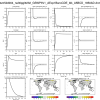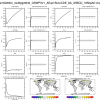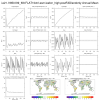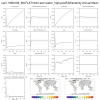I'm using CESM2.1.5
I'm trying to spin up the land carbon cycle in an I-case (CLM only) to eventually use as an initial condition for land in a B-case in emissions-driven mode.
First I ran an F-case to save coupler history output.
Then I ran 300 years of an I-case with AD mode on, driven by coupler history output. Things looked fairly equilibrated, but I realize that I may not have reached equilibrium with AD mode turned on. (see plots below)
Next I ran a new I-case with AD mode off, using the land restart as finidat (i.e. initial condition for land from the AD mode on case).
The carbon does not look equilibrated after 150 years especially for soil carbon, but curiously is equilibrating in the opposite direction from the way it was going with AD mode on. (i.e. soil carbon was decreasing in AD mode on, increasing with AD mode off). (see plots below) I tried both a hybrid branch and a startup run, they seemed to have equivalent carbon behavior.
Some questions:
1. Since AD mode and non-AD mode are going in opposite directions does running more time in AD mode help solve this problem?
2. How long approximately do you typically have to run with AD mode off after AD mode was on?
2. Is there something else I'm missing about how to do this spin up?
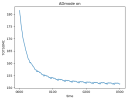
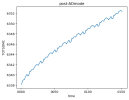
I'm trying to spin up the land carbon cycle in an I-case (CLM only) to eventually use as an initial condition for land in a B-case in emissions-driven mode.
First I ran an F-case to save coupler history output.
Then I ran 300 years of an I-case with AD mode on, driven by coupler history output. Things looked fairly equilibrated, but I realize that I may not have reached equilibrium with AD mode turned on. (see plots below)
Next I ran a new I-case with AD mode off, using the land restart as finidat (i.e. initial condition for land from the AD mode on case).
The carbon does not look equilibrated after 150 years especially for soil carbon, but curiously is equilibrating in the opposite direction from the way it was going with AD mode on. (i.e. soil carbon was decreasing in AD mode on, increasing with AD mode off). (see plots below) I tried both a hybrid branch and a startup run, they seemed to have equivalent carbon behavior.
Some questions:
1. Since AD mode and non-AD mode are going in opposite directions does running more time in AD mode help solve this problem?
2. How long approximately do you typically have to run with AD mode off after AD mode was on?
2. Is there something else I'm missing about how to do this spin up?



